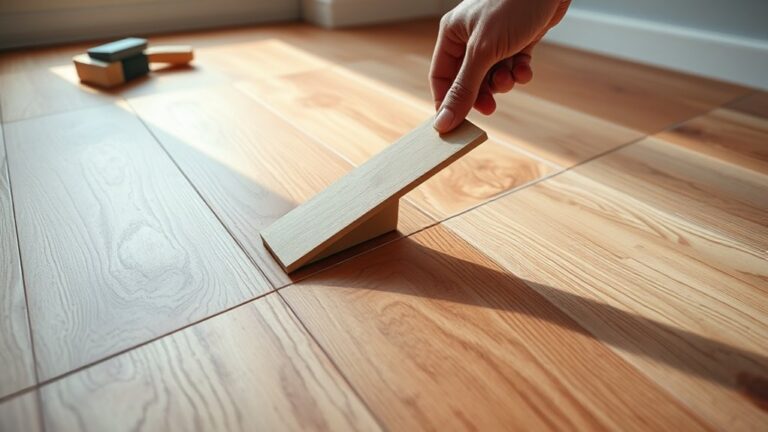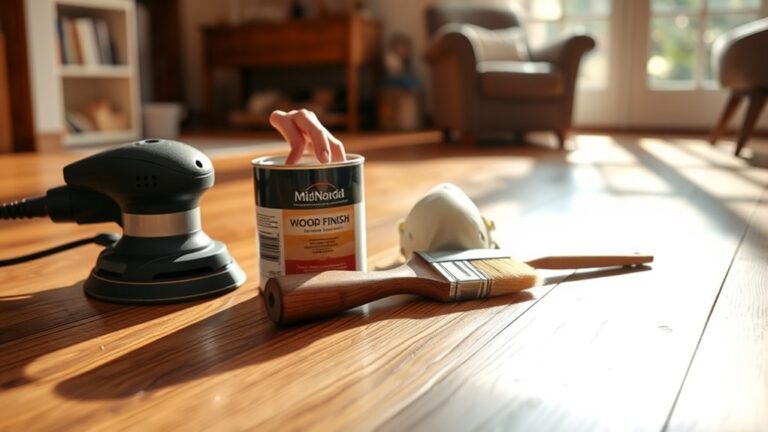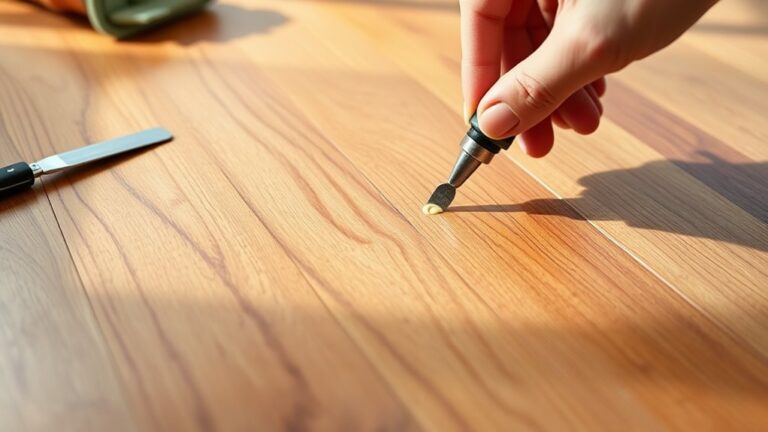When choosing the best flooring for heated floor installation, aim for high thermal conductivity materials. Ceramic and stone tiles excel at heat transfer, while polished concrete and engineered wood provide stable options that resist warping. Luxury vinyl plank (LVP) can be suitable but should be kept below 80.6°F. Verify any flooring you select, including laminate and bamboo, is fully compatible with radiant systems. Thick carpets or certain softwoods might limit heat flow, so check their specifications. Proper insulation is crucial for efficiency. There's much more to reflect on for ideal setup and longevity, so keep exploring your options.
Ideal Flooring Materials
When selecting the ideal flooring materials for heated floors, what factors should you consider to secure peak performance? One of the primary considerations is heat conductivity. Ceramic and stone tiles rank among the best options for heated floors due to their excellent thermal conductivity. They efficiently transfer heat from your radiant heating system, ensuring your space remains cozy and warm.
If you're leaning toward a wood option, engineered wood flooring is a solid choice. It's engineered to handle temperature and moisture fluctuations, making it stable and durable under heat. This means you won't have to worry about warping or damage over time.
Concrete is another excellent material, especially polished concrete. It heats up quickly and works well with both electric and water-based underfloor heating systems. Its high thermal conductivity ensures even heat distribution across your space.
Luxury vinyl plank (LVP) can also be a good fit. It offers a warm feel underfoot and comes in various styles to suit your aesthetic. Just keep in mind that it should remain below 80.6°F to avoid potential damage.
Wood Flooring Options
Choosing the right wood flooring for heated floors involves considering several key options, each with distinct advantages. Engineered flooring stands out as the best choice for heated systems due to its density and stability. Unlike solid hardwood, engineered wood can withstand temperature and moisture fluctuations, greatly reducing the risk of warping. This makes it ideal for maximizing heat output and ensuring efficient heat transfer.
Bamboo flooring is another excellent option, as it shares similar thermal properties with engineered wood. Its ability to conduct heat effectively allows for consistent warmth throughout your space. If you're considering solid hardwood, it's vital to check the manufacturer's maximum heat tolerance. While it can be used, solid hardwood may experience gapping and crowning under extreme temperature changes, which could compromise its integrity over time.
Softwood flooring can also be suitable, provided its thickness enables adequate heat output. Thicker softwoods can help maintain proper heat transfer efficiency, making them a viable choice for underfloor heating. Finally, parquet flooring can be a stylish option, but compatibility varies widely. Always verify whether the specific engineered or solid parquet options are appropriate for radiant heating applications to avoid potential issues.
Compatibility of Other Flooring Types
While wood flooring options like engineered and bamboo are popular for heated floors, other flooring types also offer compatibility with underfloor heating systems. Understanding the thermal properties and heat output of these materials is vital for achieving optimal comfort and efficiency in your home.
Here's a quick overview of various flooring types compatible with radiant floor heating systems:
| Flooring Type | Compatibility Notes |
|---|---|
| Vinyl Flooring | Can operate safely up to 80.6°F; less ideal for high heat loss areas. |
| Laminate Flooring | Compatible with radiant heat; check manufacturer guidelines to avoid warranty issues. |
| Carpet | Usable if total tog of materials doesn't exceed 2.5 tog, guaranteeing sufficient heat output. |
| Rubber Flooring | Highly conductive; responds quickly to temperature changes, ideal for radiant heating. |
| Softwood | May be compatible if thickness allows for heat transfer; be cautious of humidity effects. |
When you're considering heated floors, each material's compatibility matters. Vinyl flooring provides a safe, though limited, option. Laminate can mimic the look of wood while functioning well with radiant systems but requires verification from the manufacturer. For carpet, keeping the tog rating in check is essential to maintain effective heat output. Rubber flooring shines in quick heat responsiveness, while softwood's effectiveness hinges on its thickness and environmental conditions. Make sure you choose wisely to enjoy the benefits of heated floors!
Factors Influencing Heat Output
Understanding the factors influencing heat output is fundamental for maximizing the efficiency of your heated floors. One of the primary elements is the thermal conductivity of the flooring materials you choose. High conductivity materials like tile and stone greatly enhance heat transfer, providing ideal performance for heated systems. Conversely, materials with lower conductivity can hinder heat flow, reducing overall efficiency.
The size of the area you're heating also plays an important role. Larger spaces may require more strategic planning regarding your flooring choices to guarantee effective warmth distribution. A simple two-degree increase in floor temperature can dramatically boost heat output efficiency, contributing to improved comfort levels throughout the space.
Flooring thickness is another significant factor. Materials with a recommended maximum thickness of 3/4 inch are ideal, as they allow for responsive heating systems that provide quicker heat-up times. This responsiveness is essential for maintaining a comfortable environment without excessive energy consumption.
Additionally, insulation beneath your heating system is critical for maximizing efficiency. Proper insulation prevents heat loss downward, directing more warmth upward into your living area. By focusing on these factors—thermal conductivity, space size, temperature increments, thickness, and insulation—you can greatly enhance the performance of your heated floors. Prioritizing these elements guarantees you get the best output from your heating system, allowing you to enjoy the freedom and comfort of warm floors in your home.
Installation Considerations
Proper installation of heated floors is vital for guaranteeing ideal performance and longevity of the system. One of the key installation considerations is adhering to the manufacturer guidelines for flooring materials. This not only maintains warranty validity but also guarantees compatibility with radiant heating systems. Failing to follow these guidelines might lead to inefficient heating or even damage to the flooring.
Incorporating a moisture barrier is imperative, particularly for slab foundations, to prevent moisture damage that can compromise the integrity of both the flooring and heating system. Additionally, when installing heated floors, it's important to include expansion joints and gaps. These features accommodate material movement and temperature fluctuations, preventing buckling and guaranteeing stability.
To enhance heat transfer efficiency, consider using insulating boards beneath the heating system. This can greatly improve the responsiveness and effectiveness of your floor heating, making it a more comfortable environment.
Given the complexity of materials like tile, professional installation is highly recommended. Skilled professionals can navigate the intricacies of these materials, reducing the risk of costly mistakes. They understand the importance of proper alignment, spacing, and securing methods that will guarantee the system operates as intended. Ultimately, investing in professional installation and adhering to these installation considerations will provide you with a reliable, efficient, and long-lasting heated floor system.
Maintenance and Care Tips
Maintaining your heated floors is vital for guaranteeing their longevity and peak performance. Regularly inspect your flooring materials for signs of wear and tear, such as cracks or warping. Addressing these issues promptly will prevent more serious damage and preserve the integrity of your flooring options.
To maintain heat efficiency, keep your floors clean using appropriate cleaning methods tailored to each material type. For tiles, sweeping is effective, while vacuuming works best for carpets. Be mindful of the total tog of your carpet materials; keeping it under 2.5 tog will prevent heat blockage and guarantee effective heating.
Periodic checks on your radiant heating system components—like thermostats and sensors—are essential for maintaining peak performance. This guarantees that your heating system operates as intended, providing consistent comfort.
Always follow manufacturer-specific care instructions for your flooring materials. This will not only help preserve your warranty but also enhance the longevity of your floors under radiant heating.
Frequently Asked Questions
What Type of Flooring Is Best for Heated Floors?
When seeking the superior surface for your heated floors, consider enchanting choices like luxury vinyl, engineered hardwood, or moisture-resistant cork flooring. Tile choices, particularly porcelain, excel in thermal conductivity, ensuring even warmth. Laminate options can mimic aesthetics at a lower cost, while bamboo flooring provides sustainable style. For radiant heat, focus on installation tips to enhance efficiency and durability. Ultimately, balance cost considerations with comfort to create your ideal heated haven.
What Type of Floor Is Best for Underfloor Heating?
When considering the best floor for underfloor heating, look at wood flooring for its aesthetic appeal and insulation properties. Engineered wood offers better heat conductivity and moisture resistance, making it ideal for the installation process. While cost considerations are important, remember that energy efficiency can offset expenses over time. For maximum performance, choose materials suited to your room's needs, and follow maintenance tips to guarantee longevity and comfort.
What Flooring Is Not Suitable for Underfloor Heating?
Did you know that nearly 30% of heat can be lost through poorly chosen flooring? When considering underfloor heating, avoid carpet with excessive thickness, as it hinders heat transfer. Solid hardwood's flexibility can lead to issues like gapping from temperature changes. Additionally, thick laminate may reduce heat responsiveness, while vinyl's compatibility is questionable under high temperatures. Area rugs and cork insulation also block heat, making them unsuitable choices for effective installation methods.
Is Porcelain or Ceramic Better for Heated Floors?
When deciding between porcelain and ceramic for heated floors, consider porcelain's durability and lower water absorption, which enhance longevity. Ceramic offers better heat retention but can be more cost-effective. Installation differences can impact warmth distribution, while tile thickness shouldn't exceed 3/4 inch for ideal heating. Aesthetic options vary, and both require maintenance, though porcelain typically needs less. Finally, evaluate slip resistance, especially in warmer areas, for safety and comfort.




